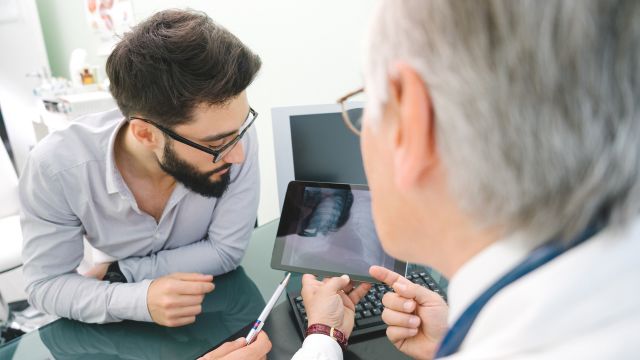Updated on April 10, 2024.
Lung cancer is very common, and accounts for almost one-quarter of death from cancer in the U.S. About 90 percent of lung cancer cases are due to smoking.
“Lung cancer is the most common cancer worldwide,” says cardiac and thoracic surgeon Matthew Arneson, MD, of Wesley Medical Center in Wichita, Kansas.
Lung cancer is often diagnosed when it is more advanced, which can make it harder to treat and contributes to low five-year survival rates (the percent of people who are alive five years after being diagnosed with a certain medical condition). Just over half of people with lung cancer survive past five years if their cancer hasn’t spread at the time it was diagnosed. That number decreases to about one in five if the cancer has already spread to other areas of the body before it was found.
“Only about 15 percent of people [of people with lung cancer] get diagnosed at an early stage,” adds Dr. Arneson. “Our goal is to increase that 15 percent so we can treat them earlier and have a better cure rate.”
Lung cancer screening may help to identify the disease at earlier stages. Here's what to know about it.
Should you be screened?
According to guidelines issued by the U.S. Preventive Services Task Force (USPSTF) in March 2021, you should get screened annually for lung cancer if you’re between the ages of 50 and 80 and you:
- Smoke cigarettes currently or have quit smoking within the past 15 years
- Have a 20 pack-year smoking history
A “pack-year” is a measure of how much a person has smoked in their lifetime, calculated by taking the number of packs they smoke per day times the number of years they smoked. So, if you’ve smoked one pack a day for 20 years, or two packs a day for 10 years, you fit the criteria.
A low-dose computed tomography (CT) scan is the only reliable screening method for lung cancer, says Arneson. CT scans use low-dose X-rays and a computer to take detailed pictures of the inside of your body. Other tests that have been used in the past include sputum tests, which look for cancer cells in your saliva, and chest X-rays. A 2012 study compared CT scans and X-rays, and found that CT scans were better than X-rays for screening for lung cancer.
“CT scans are a lot more specific,” according to Arneson. “With a chest X-ray, you often can’t see nodules [irregular growths of tissue] that are close to the heart or other organs. The other thing is, some nodules are very small and the X-ray is not as sensitive [accurate at identifying disease] in finding small nodules. The smaller the nodule, the more likely it is to be cured.”
Benefits and risks
The benefit of lung cancer screening is that it can help detect small growths early. Earlier detection of lung cancer can help you start treatment earlier when it may work better, rather than if you waited for symptoms to appear. Symptoms of lung cancer can include coughing up blood, pain, shortness of breath and weight loss.
“Unfortunately, when symptoms arise, it means the cancer has advanced,” says Arneson.
According to Arneson, the risks of screening are few. “Low-dose” CT scans do expose you to a low level of radiation, according to the USPSTF. But the amount of radiation used for low-dose CT scans is about the same, and sometimes less than, the background radiation from the environment an average person in the U.S. is exposed to during the course of a year.
One risk is the potential for false positives, says Arneson. This is when screening shows something that looks like lung cancer, and further testing shows it is not actually cancer. About 97.5 percent of all positive lung cancer screenings turn out to be false positives, according to a January 2017 study in JAMA Internal Medicine.
“That’s why before anyone gets a CT scan, there’s a conversation about options and the risks of false positives and negatives,” says Arneson. “No test is 100 percent accurate.”
Talk to your HCP if you’re a current or former smoker between ages 50 and 80 to see if screening is right for you, and ask how your insurance may help cover costs.







